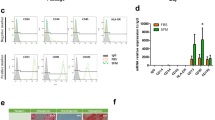Abstract
Mesenchymal stem cells (MSCs) are must be cultured in chemically defined, xeno-free culture system for cell-based therapies. One major overcome for their clinical use is the unsafety of fetal bovine serum (FBS), which is a crucial part of all media currently used for the culture of MSCs. Previously, we developed novel methods the production of silkworm gland hydrolysate (SGH). Also, we showed the effect of the SGH on the cell growth promotion. We demonstrated whether the characteristics of MSCs were maintained in the serum-free media containing SGH during long-term cultivation. The results of microscopic observation showed that the morphology of stem cells were not different between the media containing 10% FBS and 1 mg/mL SGH. After the long-term culture of MSCs in serum-free media containing SGH, the rate of MSCs growth was well maintained. The analysis of anti-apoptotic effect of SGH showed that early apoptosis of MSCs was reduced by 3.7-fold. Furthermore, MSCs specific surface markers and stemness gene expression (Nanog, Sox2) were preserved as that of MSCs in the media containing 10% FBS. In conclusion, we demonstrate that the SGH can be used as useful supplement for MSCs cultivation in serumfree media.
Similar content being viewed by others
References
LG Chase, MT Firpo, Development of serum-free culture systems for human embryonic stem cells, Curr Opin Chem Biol, 11, 367 (2007).
SA Tarle, S Shi, D Kaigler, Development of a serum-free system to expand dental-derived stem cells: PDLSCs and SHEDs, J Cell Physiol, 226, 66 (2011).
ME Rodrigues, AR Costa, M Henriques, et al., Comparison of commercial serum-free media for CHO-K1 cell growth and monoclonal antibody production, Int J Pharm, 437, 303 (2012).
DY Kim, JC Lee, HN Chang, et al., Development of serumfree media for a recombinant CHO cell line producing recombinant antibody, Enzyme Microb Technol, 39, 426 (2006).
SH Kim, GM Lee, Development of serum-free medium supplemented with hydrolysates for the production of therapeutic antibodies in CHO cell cultures using design of experiments, Appl Microbiol Biotechnol, 83, 639 (2009).
S Richards, D Leavesley, G Topping, et al., Development of defined media for the serum-free expansion of primary keratinocytes and human embryonic stem cells, Tissue Engineering — Part C: Methods, 14, 221 (2008).
JE Hudson, RJ Mills, JE Frith, et al., A defined medium and substrate for expansion of human mesenchymal stromal cell progenitors that enriches for osteo-and chondrogenic precursors, Stem Cells Dev, 20, 77 (2011).
P Horn, G Bokermann, D Cholewa, et al., Impact of individual platelet lysates on isolation and growth of human mesenchymal stromal cells, Cytotherapy, 12, 888 (2010).
JL Spees, CA Gregory, H Singh, et al., Internalized antigens must be removed to prepare hypoimmunogenic mesenchymal stem cells for cell and gene therapy. Mol Ther, 9, 747 (2004).
K Turnovcova, K Ruzickova, V Vanecek, et al., Properties and growth of human bone marrow mesenchymal stromal cells cultivated in different media Expansion of MSC in different media, Cytotherapy, 11, 874 (2009).
J Jung, N Moon, JY Ahn, et al., Mesenchymal stromal cells expanded in human allogenic cord blood serum display higher self-renewal and enhanced osteogenic potential, Stem Cells Dev, 18, 559 (2009).
A Kocaoemer, S Kern, H Klüter, et al., Human AB serum and thrombin-activated platelet-rich plasma are suitable alternatives to fetal calf serum for the expansion of mesenchymal stem cells from adipose tissue, Stem Cells, 25, 1270 (2007).
C Capelli, M Domenghini, G Borleri, et al., Human platelet lysate allows expansion and clinical grade production of mesenchymal stromal cells from small samples of bone marrow aspirates or marrow filter washouts, Bone Marrow Transplant, 40, 785 (2007).
SE Broedel and SM Papciak, The Case for Serum-Free Media, Bioprocess Int., 10, 56 (2003).
S Terada, T Nishimura, M Sasaki, et al., Sericin, a protein derived from silkworms, accelerates the proliferation of several mammalian cell lines including a hybridoma, Cytotechnology, 40, 3 (2003).
M Takahashi, K Tsujimoto, H Yamada, et al., The silk protein, sericin, protects against cell death caused by acute serum deprivation in insect cell culture, Biotechnol Let, 25, 1805 (2003).
JW Hwang, HS Lee, HJ Kim, et al., Manufacture and characterization of silkworm gland hydrolysate, J Seric Entomol Sci 50(2), 76 (2012).
YS Choi, SE Noh, SM Lim, et al., Multipotency and growth characteristic of periosteum-derived progenitor cells for chondrogenic, osteogenic, and adipogenic differentiation, Biotechnol Lett, 30, 593 (2008).
EJ Kim, HJ Park, TH Park, Inhibition of apoptosis by recombinant 30K protein originating from silkworm hemolymph. Biochem, Biophys Res Commun, 308, 523 (2003).
M Morikawa, T Kimura, M Murakami, et al., Rat islet culture in serum-free medium containing silk protein sericin, J Hepatobiliary Pancreat, 16, 223 (2009).
M Sasaki, Y Kato, H Yamada, et al., Development of a novel serum-free freezing medium for mammalian cells using the silk protein sericin, Biotechnol Appl Biochem, 42, 183 (2005).
F Sehnal, Prospects of the practical use of silk sericins, Entomol Res, 38, S1 (2008).
Author information
Authors and Affiliations
Corresponding author
Rights and permissions
About this article
Cite this article
Cha, HM., Kim, SM., Choi, YS. et al. 중간엽줄기세포 증식을 위한 누에 실샘 유래 무혈청 배지 첨가제. Tissue Eng Regen Med 12 (Suppl 1), 53–59 (2015). https://doi.org/10.1007/s13770-014-0405-0
Received:
Revised:
Accepted:
Published:
Issue Date:
DOI: https://doi.org/10.1007/s13770-014-0405-0




